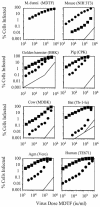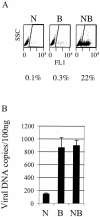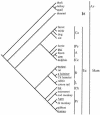Characterization of murine leukemia virus restriction in mammals
- PMID: 14645596
- PMCID: PMC296090
- DOI: 10.1128/jvi.77.24.13403-13406.2003
Characterization of murine leukemia virus restriction in mammals
Abstract
Restriction of murine leukemia virus (MLV) was examined in cells from a range of mammals. All nonmurine restrictions were saturable blocks to N-tropic MLV infection, and several were prior to reverse transcription. We demonstrate restriction in cells from bat and show that if we express the murine restriction factor Fv1 in human cells, then Fv1, not the human host, defines the stage at which infection is blocked.
Figures




Similar articles
-
Expression levels of Fv1: effects on retroviral restriction specificities.Retrovirology. 2016 Jun 24;13(1):42. doi: 10.1186/s12977-016-0276-7. Retrovirology. 2016. PMID: 27342974 Free PMC article.
-
The human TRIM5alpha restriction factor mediates accelerated uncoating of the N-tropic murine leukemia virus capsid.J Virol. 2007 Mar;81(5):2138-48. doi: 10.1128/JVI.02318-06. Epub 2006 Nov 29. J Virol. 2007. PMID: 17135314 Free PMC article.
-
Generation and characterization of a stable full-length ecotropic murine leukemia virus molecular clone that produces novel phenotypes to Fv1 restriction.J Microbiol Biotechnol. 2008 Apr;18(4):799-804. J Microbiol Biotechnol. 2008. PMID: 18467880
-
Fv1-like restriction of N-tropic replication-competent murine leukaemia viruses in mCAT-1-expressing human cells.J Gen Virol. 2002 Feb;83(Pt 2):439-442. doi: 10.1099/0022-1317-83-2-439. J Gen Virol. 2002. PMID: 11807237
-
Post-entry restriction of retroviral infections.AIDS Rev. 2003 Jul-Sep;5(3):156-64. AIDS Rev. 2003. PMID: 14598564 Review.
Cited by
-
Interfering residues narrow the spectrum of MLV restriction by human TRIM5alpha.PLoS Pathog. 2007 Dec 28;3(12):e200. doi: 10.1371/journal.ppat.0030200. PLoS Pathog. 2007. PMID: 18166079 Free PMC article.
-
TRIM5α requires Ube2W to anchor Lys63-linked ubiquitin chains and restrict reverse transcription.EMBO J. 2015 Aug 4;34(15):2078-95. doi: 10.15252/embj.201490361. Epub 2015 Jun 22. EMBO J. 2015. PMID: 26101372 Free PMC article.
-
Activation of nuclear factor-kappa B signalling promotes cellular senescence.Oncogene. 2011 May 19;30(20):2356-66. doi: 10.1038/onc.2010.611. Epub 2011 Jan 17. Oncogene. 2011. PMID: 21242976 Free PMC article.
-
Human Adaptation of Ebola Virus during the West African Outbreak.Cell. 2016 Nov 3;167(4):1079-1087.e5. doi: 10.1016/j.cell.2016.10.013. Cell. 2016. PMID: 27814505 Free PMC article.
-
Fusion of cyclophilin A to Fv1 enables cyclosporine-sensitive restriction of human and feline immunodeficiency viruses.J Virol. 2007 Sep;81(18):10055-63. doi: 10.1128/JVI.00616-07. Epub 2007 Jul 3. J Virol. 2007. PMID: 17609268 Free PMC article.
References
Publication types
MeSH terms
Substances
Grants and funding
LinkOut - more resources
Full Text Sources
Other Literature Sources

